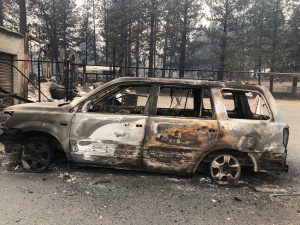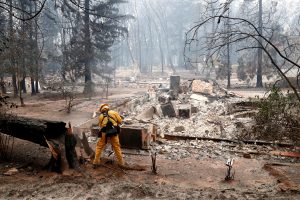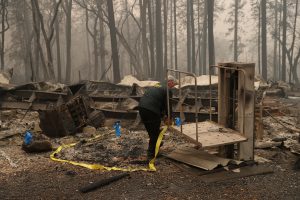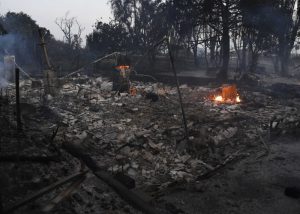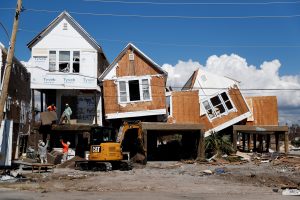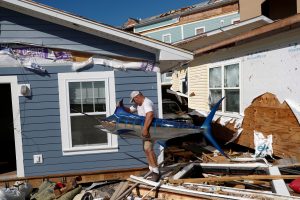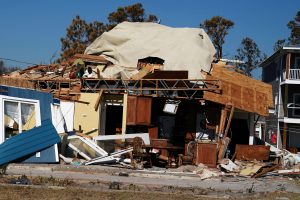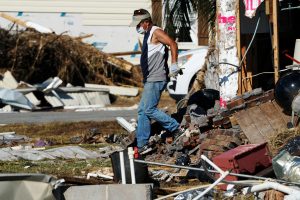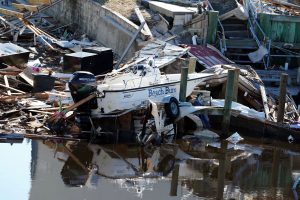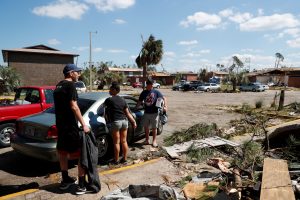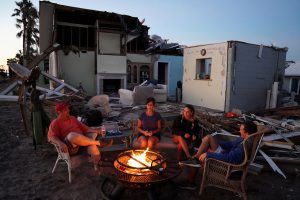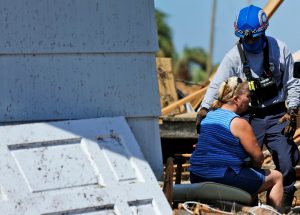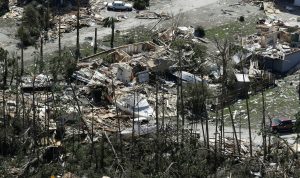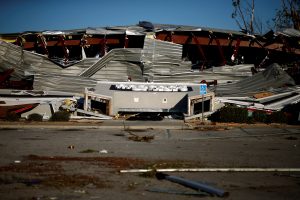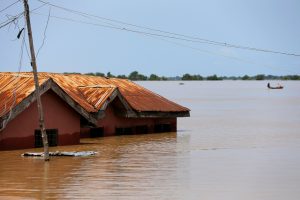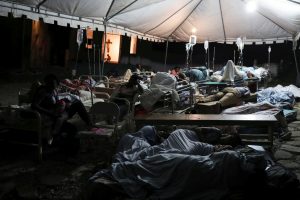
By Terray Sylvester
PARADISE, Calif. (Reuters) – Teams of rescue workers continued to sift through burned homes and vehicles on Friday for the remains of victims in the northern California town of Paradise, as the number of those missing in the state’s deadliest wildfire spiked to 630 people.
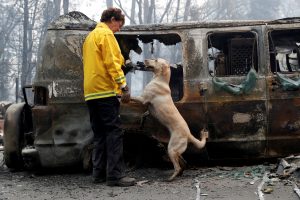
Karen Atkinson, of Marin, searches for human remains with her cadaver dog, Echo, in a van destroyed by the Camp Fire in Paradise, California, U.S., November 14, 2018. REUTERS/Terray Sylvester
At least 63 people were killed in and around Paradise, which was virtually destroyed by the Camp Fire that erupted a week ago in the Sierra foothills 175 miles (280 km) north of San Francisco. The fire is among the deadliest to have hit the United States over the last century.
Authorities attribute the death toll partly to the speed with which flames raced through the town of 27,000, driven by wind and fueled by desiccated scrub and trees.
Butte County Sheriff Kory Honea said on Thursday the remains of seven further victims had been located since Wednesday’s tally of 56. Nearly 300 people reported missing have been found alive and the list of missing would fluctuate, he said.
Many of those listed as missing during the course of the last week are over the age of 65. Local officials and realtors had long sold Paradise as an ideal place to retire.
Relatives of retired U.S. Navy veteran David Marbury, 66, are waiting to hear from him. No one has managed to speak with him since the wildfire began, and relatives’ phone calls have gone directly to his voicemail.
On Thursday, Marbury’s landlord confirmed to relatives that his duplex in Paradise had burned down. Sheriff’s officials told them his car was still in the garage.
“I really hope he’s still alive and we’re going to be able to see him,” Marbury’s niece Sadia Quint, 30, told Reuters by phone. “We just hope that he’s still with us.”
Nearly 12,000 homes and buildings burned hours after the blaze erupted, the California Department of Forestry and Fire Protection (Cal Fire) said.
Thousands of additional structures remain threatened as firefighters, many from distant states, labor to contain and suppress the flames.
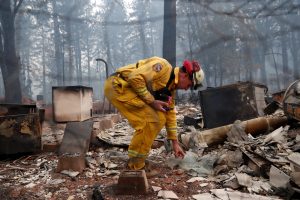
Cal Fire firefighter Stewart Morrow inspects a house destroyed by the Camp Fire in Paradise, California, U.S., November 14, 2018. REUTERS/Terray Sylvester
DNA SAMPLES
Sheriff Honea has asked relatives of the missing to submit DNA samples to hasten identification of the dead. But he said some of those unaccounted for may never be identified.
There have been other smaller blazes in southern California, including the Woolsey Fire that is linked to three fatalities and has destroyed at least 500 structures near the Malibu coast west of Los Angeles.
Scientists say two seasons of devastating wildfires in California are linked to drought that is symptomatic of climate change.
Two electric utilities say they sustained equipment problems close to the origins of the blazes around the time they were reported.
Republican U.S. President Donald Trump is due to visit the fire zones on Saturday to meet displaced residents. Critics say Trump politicized the fires by blaming them, without supporting evidence, on forest mismanagement by California, a largely Democratic state.
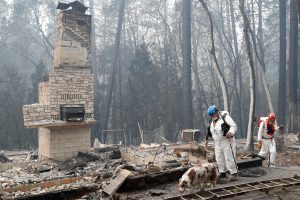
Trish Moutard (C), of Sacramento, searches for human remains with her cadaver dog, I.C., in a house destroyed by the Camp Fire in Paradise, California, U.S., November 14, 2018. REUTERS/Terray Sylvester
Cal Fire said 40 percent of the Camp Fire’s perimeter was contained, up from 35 percent, even as the blaze footprint grew 2,000 acres to 141,000 acres (57,000 hectares). The Woolsey fire was 57 percent contained.
Smoke from the Camp Fire has spread far and wide. Public schools in Sacramento 90 miles (145 km) to the south, and as far away as San Francisco and Oakland, canceled classes for Friday due to poor air quality.
Many of those who survived the flames but lost homes stayed with friends or relatives or at American Red Cross shelters.
Some of Paradise’s older residents who had lost their homes were concerned about where they would live.
“I’m just very hopeful I can work something out for the future,” Norris Godsey, 82, told the San Francisco Chronicle interview at a church evacuation center in Chico. “If that’s not possible, I don’t know what I’ll do.”
(Reporting by Terray Sylvester; Additional reporting by Brendan O’Brien in Milwaukee, Jonathan Allen in New York; Suzannah Gonzales in Chicago; Writing by Nick Carey; Editing by Matthew Mpoke Bigg and Bernadette Baum)



